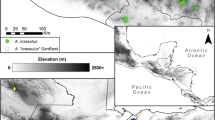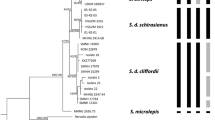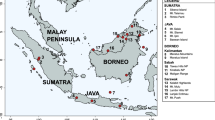Abstract
Genetic variation within the macroura species group, which includes Sminthopsis macroura, S. virginiae, S. douglasi, and S. bindi, was examined through analyses of complete mitochondrial 12S rRNA gene sequences, partial control-region DNA sequences, and allozymes. Divergent genetic lineages appear to be present within S. macroura and S. virginiae, and it is likely that this genetic divergence equates to currently unrecognized taxonomic diversity. Specimens of S. macroura (as currently recognized) belong to three genetically distinct lineages that are highly divergent from one another. Two of these lineages may be synonymous with two previously recognized dunnart species—S. froggatti and S. stalkeri. The third appears to represent "true" S. macroura and is itself genetically heterogeneous, with a number of subgroups present within it that may also represent currently unrecognized taxa. The mitochondrial DNA sequence divergences observed between S. virginiae nitela and the two other S. virginiaesubspecies are equivalent to, or greater than, those noted between other dunnart species. Allozyme divergences between these subspecies were however slightly lower, and determination on whether S. virginiae nitela should be returned to full species status (S. nitela) may require further evidence. Phylogenetic relationships between species in the macroura group appear to have been partially resolved, with individual 12S rRNA and combined mitochondrial DNA analyses recovering S. bindi as the earliest diverging taxon. Other relationships between species in the group were either not consistently recovered or lacked strong support.
Similar content being viewed by others
LITERATURE CITED
Archer M. (1981). Revision of the dasyurid marsupial genus Sminthopsis Thomas. Bull.Amer.Mus.Nat.Hist. 168: 61–224.
Archer M. (1982). Review of the dasyurid (Marsupialia) fossil record, integration of data bearing on phylogenetic interpretation and suprageneric classification. In: Carnivorous Marsupials, M. Archer, ed., pp. 397–443, Royal Zoological Sociey of NSW, Mossman.
Baverstock P. R., Archer M., Adams M., and Richardson B. J. (1982). Genetic relationships among 32 species of Australian dasyurid marsupials. In: Carnivorous Marsupials, M. Archer, ed., pp. 641–650, Royal Zoological Sociey of NSW, Mossman.
Baverstock P. R., Adams M., Archer M. (1984). Electrophoretic resolution of species boundaries in the Sminthopsis murina complex (Dasyuridae). Aust.J.Zool. 32: 823–832.
Belbin, L. (1994). PATN: Pattern Analysis Package. Technical Reference Manual, CSIRO Division of Wildlife and Ecology, Gungahlin, Canberra.
Blacket M. J., Krajewski C., Labrinidis A., Cambron B., Cooper S., and Westerman M. (1999). Systematic relationships within the dasyurid marsupial tribe Sminthopsini-A multigene approach. Mol.Phylogenet.Evol. 12: 140–155.
Blacket M. J., Adams M., Krajewski C., and Westerman M. (2000). Genetic variation within the dasyurid marsupial genus Planigale. Aust.J.Zool. 48: 443–459.
Cavalli-Sforza, L. L., and Edwards, A. W. F. (1967). Phylogenetic analysis: Models and estimation procedures. Evol. 32: 550–570.
Cole J. R. and Gibson D. F. (1991). Distribution of stripe-faced dunnarts Sminthopsis macroura and desert dunnarts S.youngsoni (Marsupialia: Dasyuridae) in the Northern Territory. Aust.Mammal. 14: 129–131.
Collett R. (1897). On a collection of mammals from North and North-west Australia. Proc.Zool.Soc.Lond. 1897: 317–336.
Cooper S. J. B., Adams M., and Labrinidis A. (2000). Phylogeography of the Australian dunnart Sminthopsis crassicaudata (Marsupialia: Dasyuridae). Aust.J.Zool. 48: 461–473.
Crowther M. S., Dickman C. R., and Lynam A. J. (1999). Sminthopsis griseoventer boullangerensis (Marsupialia:Dasyuridae), a new subspecies in the S.murina complex from Boullanger Island, Western Australia. Aust.J.Zool. 47: 215–243.
Dawson L., Muirhead J., and Wroe S. (1999). The Big Sink Local Fauna: A lower Pliocene mammalian fauna from the Wellington Caves complex, Wellington, New South Wales. Rec.West.Aust.Mus.Suppl. 57: 265–290.
Farris J. S., K¨allersj¨o M., Kluge A. G., and Bult C. (1995). Testing significance of incongruence. Cladistics 10: 315–319.
Felsenstein J. (1981). Evolutionary trees from DNA sequences: A maximum-likelihood approach. J.Mol.Evol. 17: 368–376.
Felsenstein J. (1985). Confidence limits on phylogenies: An approach using the bootstrap. Evol. 39: 783–791.
Felsenstein J. (1993). PHYLIP: (Phylogeny inference package), version 3.5c (distributed by the author), Department of Genetics, University of Washington, Seattle.
Fitch W. M., and Margoliash E. (1967). Construction of phylogenetic trees. SCI. 155: 279–284.
Flannery, T. F. (1995). The Mammals of New Guinea, Reed, Chatswood NSW.
Godfrey G. A. (1966). Daily torpor in the marsupial mouse, Sminthopsis larapinta (Spencer). Nat.212: 1248–1249.
Godfrey G. A. (1968). Body-temperatures and torpor in Sminthopsis crassicaudata and S.larapinta (Marsupialia-Dasyuridae). J.Zool. 156: 499–511.
Godfrey G. A. (1969). Reproduction in a laboratory colony of the marsupial mouse Sminthopsis larapinta (Marsupialia-Dasyuridae). Aust.J.Zool. 17: 637–654.
Gould J. (1845). Five new species of mammals. Proc.Zool.Soc.Lond. 1845: 77–79.
Heatwole, H. (1987). Major components and distributions of terrestrial fauna. In: Fauna of Australia.Volume 1A, General Articles, G.R. Dyne and D. W. Walton, eds., pp. 101–135, Australian Government Publishing Servive, Canberra.
Kirsch J. A. W. (1967). Comparative Serology of Marsupials. Ph.D. thesis, University of Western Australia, Perth.
Kirsch J. A. W. (1977). The comparitive serology of Marsupialia, and a classification of marsupials. Aust.J.Zool. Suppl. Ser. 52: 1–152.
Kitchener D. J., Stoddart J., and Henry J. (1984). A taxonomic revision of the Sminthopsis murina complex (Marsupialia: Dasyuridae) in Australia, including descriptions of four new species.Rec.West.Aust.Mus. 11: 201–248.
Krajewski C., Blacket M., Buckley L., and Westerman M. (1997). A multigene assessment of phylogenetic relationships within the dasyurid marsupial subfamily Sminthopsinae. Mol.Phylogenet.Evol. 8: 236–248.
Krajewski C., Fain M. G., Buckley L., and King D. G. (1999). Dynamically heterogenous partitions and phy-logenetic inference: An evaluation of analytical strategies with cytochrome b and ND6 gene sequences in cranes. Mol.Phylogenet Evol. 13: 302–313.
Krajewski C., Wroe S., and Westerman M. (2000). Molecular evidence for phylogenetic relationships and the timing of cladogenesis in dasyurid marsupials. Zool.J.Linn.Soc. 130: 375–404.
McKenzie N. L., and Archer M. (1982). Sminthopsis youngsoni (Marsupialia: Dasyuridae), the lesser hairyfooted dunnart, a new species from arid Australia. Aust.Mammal. 5: 267–279.
Morton S. R., Armstrong M. D., and Braithwaite R. W. (1987). The breeding season of Sminthopsis virginiae (Marsupialia: Dasyuridae) in the Northern Territory.Aust.Mammal. 10: 41–42.
Muirhead J. and Wroe S. (1998). The family Thylacinidae and a description and analysis of a new species: Badjcinus turnbulli gen. et sp. nov. (Thylacinidae: Marsupialia), from the late Oligocene of Riversleigh, northwestern Queensland, Australia. J.Vertebr.Paleontol. 18: 612–626.
Nei, M. 1978. Estimation of average heterozygosity and genetic distance from a small number of individuals. Genet. 89: 583–590.
Ramsay E. P. (1887). Descriptions of two new species of marsupials (Perameles and Antechinus), and of a new species of Mus (M.burtoni), from the neighbourhood of Derby, W.A. Proc.Linn.Soc.N.S.W. 2: 551–553.
Richardson, B. J., Baverstock, P. R., and Adams, M. (1986). Allozyme Electrophoresis: A Handbook for Animal Systematics and Population Studies. Academic Press, Sydney, NSW.
Roberts J. D. and Maxson L. R. (1985). Tertiary speciation models in Australian anurans: Molecular data challenge Pleistocene scenario. Evol. 39: 325–334.
Rogers, J. S. (1972). Measures of genetic similarity and genetic distance. Stud Genet.VII-University of Texas Publication number 7213: 145–153.
Saccone C., Attimonelli M., and Sbisa E. (1987). Structural elements highly preserved during the evolution of the D-loop-containing region in vertebrate mitochondrial DNA. J.Mol.Evol. 26: 205–211.
Saitou N. and Nei. (1987). The neighbor-joining method: A new method for reconstructing phylogenetic trees. Mol.Biol.Evol. 4: 406–425.
Shiozawa D. K., Kudo J., Evans R. P., Woodward S. R., and Williams R. N. (1992). DNA extraction for preserved trout tissues. Great Basin Nat. 52: 29–34.
Smith A. B. (1994). Rooting molecular trees: Problems and strategies. Biol.J.Linn.Soc. 31: 279–292.
Smith M. J. and Medlin G. C. (1982). Dasyurids of the northern Flinders ranges before pastoral development. In: Carnivorous Marsupials, M. Archer, ed., pp. 563–572, Royal Zoological Society NSW, Mossman.
Spencer W. B. (1896). Preliminary descriptions of certain new marsupials from central Australia together with remarks upon the occurrence and identity of Phascogale cristicaudata. Proc.R.Soc.Victoria 8:5–13.
Springer M. and Douzery E. (1996). Secondary structure and patterns of evolution among mammalian mitochondrial 12S rRNA molecules. J.Mol.Evol. 43: 357–373.
Strahan R. (1995). The Mammals of Australia, The Australian Museum and Reed Books, Chatswood, NSW.
Taplin L. E. (1980). Some observations on the reproductive biology of Sminthopsis virginiae (Tarragon), (Marsupialia: Dasyuridae). Aust.Zool. 20: 407–418.
Thomas O. (1888). Catalogue of the Marsupialia and Monotremata in the Collection of the British Museum (Natural History), British Museum (Natural History), London.
Thomas O. (1906). On mammals from northern Australia presented to the National Museum by Sir Wm. Ingram, Bt., and the Hon. John Forrest. Proc.Zool.Soc.Lond. 1906: 536–543.
Troughton E. (1964). A review of the marsupial genus Sminthopsis (Phascogalinae) and diagnoses of new forms. Proc.Linn.Soc.N.S.W. 89: 307–321.
Van Dyck S. (1986). The chestnut dunnart, Sminthopsis archeri (Marsupialia: Dasyuridae), a new species from the savannahs of Papua New Guinea and Cape York Peninsula, Australia. Aust.Mammal. 9: 111–124.
Van Dyck S. M. and Longmore N. W. (1991). The mammal records. In: An Atlas of Queensland's Frogs, Reptiles, Birds and Mammals, G. J. Ingram and R. J. Raven, eds., pp. 284–353, Board of Trustees, Queensland Museum, Brisbane.
Van Dyck S., Woinarski, J. C. Z., and Press, A. J. (1994). The Kakadu dunnart Sminthopsis bindi (Marsupialia: Dasyuridae), a new species from the stony woodlands of the Northern Territory. Mem.Queensland Mus. 37: 311–323.
Wirgin I., Maceda L., Stabile J., and Mesing C. (1997). An evaluation of introgression of Atlantic coast striped bass mitochondrial DNA in a Gulf of Mexico population using formalin-preserved museum collections. Mol.Ecol. 6: 907–916.
Woinarski J. C. Z., Woolley P. A., and Van Dyck S. (1996). The distribution of the dunnart Sminthopsis butleri. Aust.Mammal. 19: 27–29.
Woolley P. A. (1990). Reproduction in Sminthopsis macroura (Marsupialia: Dasyuridae) I. The female. Aust.J.Zool. 38: 187–205.
Woolley P. A. (1994). The dasyurid marsupials of New Guinea: Use of museum specimens to assess seasonality of breeding. Sci.New Guinea 20: 49–55.
Woolley P. A. (1995). Red-cheeked dunnart Sminthopsis virginiae. In: The Mammals of Australia, R. Strahan, ed., pp 156–157, The Australian Museum and Reed Books, Chatswood, NSW.
Author information
Authors and Affiliations
Corresponding author
Rights and permissions
About this article
Cite this article
Blacket, M.J., Adams, M., Cooper, S.J.B. et al. Systematics and Evolution of the Dasyurid Marsupial Genus Sminthopsis: I. The Macroura Species Group. Journal of Mammalian Evolution 8, 149–170 (2001). https://doi.org/10.1023/A:1011322031747
Issue Date:
DOI: https://doi.org/10.1023/A:1011322031747




